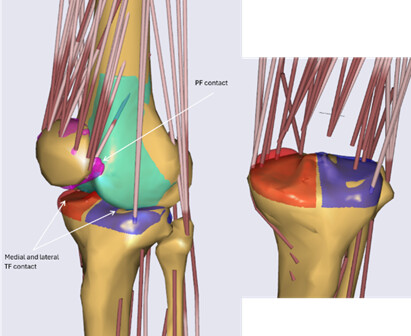Good day @dschander @Hamed-Shayestehpour @pgalibarov
I have a question regarding the effect of partial bone morphing on the contact surface/force. I performed partial bone morphing of the distal end of the femur and distal part of the tibia. I observed that tibia bone of the generic model did not match that of the subject's tibia due to the limited number of landmarks. when registering the contact surfaces, I got the following surfaces:

I created an offset with the tibial bone to represent the cartilage. You can see that the blue surface is not consistent. The surface was underneath the bone at the lateral region of the blue surface (note that the surface has no holes). I do believe that this is because of the level of the morphing.
My question:
1. What would be the impact of this configuration on the contact forces calculation?
2. Does this configuration affect the penetration depth which is used to calculate the penetration volume and eventually the contact force?
The contact forces are dependent on the pressure module and penetration volume:

And I know that penetration volume, Vi, is approximated by
multiplying the vertex penetration depth (di) by the opponent triangle
area, Ai,
![]()
I do expect that di would differ depending on how well the morphing was performed (if generic bone was morphed perfectly , the offset will be more representative of the cartilage). 3. Is this true?
Best regards,
Omar